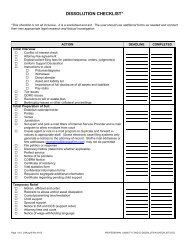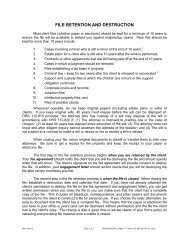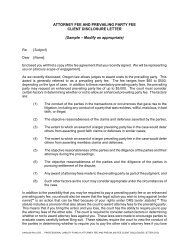Calendaring, Docketing, and File Tickling Systems - Professional ...
Calendaring, Docketing, and File Tickling Systems - Professional ...
Calendaring, Docketing, and File Tickling Systems - Professional ...
Create successful ePaper yourself
Turn your PDF publications into a flip-book with our unique Google optimized e-Paper software.
FOLLOW-UPOne of the most important aspects of docket control is to follow up once a reminder is made tosee that a task is actually accomplished prior to its deadline date. Unfortunately, this is also oneof the most overlooked requirements of a good docket system.On occasion, an item will be held for one final review. Make sure the item does not get buried ona desk or in the file. If an item is sent by certified mail, enter a follow-up date to verify the returnreceipt came back to the office. If an item is filed, check to be sure that the item was received bythe court. When sending documents out for service, enter a follow-up date to check with theprocess server confirming that service has been accomplished. This is especially crucial if servicemust be made within 60 days of filing the complaint when there is a statute of limitations problem.Use your docket or follow-up system for any matter that has an irrevocable deadline, such asgiving notice of a claim, filing a complaint, effecting service of summons, or filing notice ofappeal, Some other important dates are: notices of annual meetings for corporations, probatedeadlines, notice of sale in foreclosures, tax filing deadlines, <strong>and</strong> intangible dates such as when tohave a will or pension <strong>and</strong> profit sharing plan completed. There are specific deadlines <strong>and</strong> datesfor each practice area. Consult the PLF Practice Aids <strong>and</strong> Forms <strong>and</strong> your OSB CLE materials forchecklists <strong>and</strong> forms.Important treatment in the docket control system:1 . The final deadline should be immediately entered on the calendars of the attorney,secretary, <strong>and</strong> the central docket clerk.2. Sufficient lead time should be determined for completion of each task, <strong>and</strong> appropriatereminder dates entered in the calendars of the attorney <strong>and</strong> secretary, as well as thecentral docket system.3. Final reminders should be specially indicated (i.e., red ink or bold if using a papercalendar).4. Reminder notices <strong>and</strong> follow-ups should be brought to the attorney’s attention <strong>and</strong> tasksshould be marked off when completed <strong>and</strong> by whom. A separate follow-up log for eachcase can be maintained so that these important actions, deadlines, <strong>and</strong> follow up tasks arenoted, along with information about when they were accomplished <strong>and</strong> by whom.5. This is the most important step: If the secretary or docket clerk does not receive notice thatthe task has been completed by the due date, that person should immediately contact theresponsible attorney to find out why the task has not been completed.6. In the event a final notice is ignored or the responsible attorney is unavailable for anyreason, the supervising/managing attorney should be notified of the problem by thesecretary or person in charge of the docket. A firm policy should be created to addressthis potential situation. See Oregon RPC 5.1 Responsibilities of Partners, Managers, <strong>and</strong>Supervisory Lawyers.[3-May-07 Rev 5/07]PROFESSIONAL LIABILITY FUND (FOLLOW-UP.DOC)
















